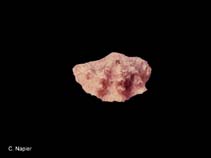Tridacna squamosa Lamarck, 1819
Fluted giant clam| Native range | All suitable habitat | Point map | Year 2050 |

|
| This map was computer-generated and has not yet been reviewed. |
| Tridacna squamosa AquaMaps Data sources: GBIF OBIS |
رده بندی / Names اسامي عام | مترادف | CoL | ITIS | WoRMS
Bivalvia | Cardiida | Cardiidae
Environment: milieu / climate zone / تغييرات عمق / distribution range بوم شناسي
; تغييرات عمق 0 - 42 m (مرجع 117184). Tropical; 31°N - 32°S, 30°E - 124°W
Distribution كشورها | مناطق سازمان خوار و بار جهاني (FAO) | Ecosystems | ظهور | معرفي
Indo-Pacific: from East Africa to the Red Sea, (but not the Persian Gulf) to as far east as Pitcairn Islands, north to southern Japan, and south to Queensland, Australia and New Caledonia. Introduced in Hawaii and Guam.
Length at first maturity / Size / Weight / سن
بلوغ: Lm ?, range 16 - 20 cm Max length : 45.0 cm SHL جنس نر / بدون خواص جنسي; (مرجع 95990); common length : 30.0 cm SHL جنس نر / بدون خواص جنسي; (مرجع 348)
توصيف مختصر ريخت شناسي
Life cycle and mating behavior بلوغ | تولید مثل | تخم ریزی | Eggs | Fecundity | Larvae
مآخذ اصلی
مراجع | هماهنگ كننده | همكاران
SAUP Database 2006 SAUP Database. www.seaaroundus.org. (مرجع 356)
وضعيت در فهرست قرمز IUCN
(مرجع 130435: Version 2025-1)
وضعيت از نظر سايتس (مرجع 108899)
CMS (مرجع 116361)
خطر برای انسان ها
استفاده انسانی
ماهي گيري – شيلات: تجاري
FAO - آبزي پروري: production; | FishSource | Sea Around Us
ابزارها
اطلاعات بيشتر
منابع اينترنتي
BHL | BOLD Systems | CISTI | DiscoverLife | FAO(; publication : search) | Fishipedia | GenBank (ژنوم, نوکلئوتيد) | GloBI | Gomexsi | Google Books | Google Scholar | Google | PubMed | Tree of Life | Wikipedia (برو, جستجو) | Zoological Record



